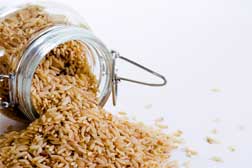|
| |
'White rice raises, brown
rice cuts diabetes'
Main
Article page | Health page|
Fitness articles|
Diseases

In a finding which may have
implications for Asians, including Indians, whose staple
food is rice, scientists claim to have found that eating
white rice could increase one's risk of developing type
2 diabetes while the brown variety can lower the risk of
the disease.
A new study
by the Harvard School of Public Health has found that
eating five or more servings of white rice per week is
associated with an increased risk of type 2 diabetes,
while consuming two or more servings of brown rice every
week could lower the risk substantially.
"The study
is the first to specifically examine white rice and
brown rice in relation to diabetes risk," said Qi Sun,
who led the team.
"Rice
consumption in the US has dramatically increased in
recent decades. We believe replacing white rice and
other refined grains with whole grains, including brown
rice, would help lower the risk of type 2 diabetes,"
said Sun.
Brown rice
is superior to white rice when it comes to fibre
content, minerals, vitamins, and phytochemicals, and it
often does not generate as large an increase in blood
sugar levels after a meal.
Milling and
polishing brown rice removes most vitamins and minerals.
In addition, milling strips away most of its fibre,
which helps deter diabetes by slowing the rush of sugar
(glucose) into the bloodstream.
For their
study, the scientists examined white and brown rice
consumption in relation to type 2 diabetes risk in
157,463 women and 39,765 men participating in the
Brigham and Women's Hospital-based Nurses' Health Study
I and II and the Health Professionals Follow-up Study.
They
analysed responses to questionnaires about diet,
lifestyle, and health conditions which participants
completed every four years. The team documented 5,500
cases of type 2 diabetes during 22 years of follow-up in
NHS 1 participants, 2,359 cases over 14 years in NHS II
participants, and 2,648 cases over 20 years in
participants.
Sun and his
colleagues found that the biggest consumers of white
rice were less likely to have European ancestry or to
smoke and more likely to have a family history of
diabetes. Eating brown rice was not associated with
ethnicity but with a more health-conscious diet and
lifestyle.
In the
analysis, the scientists adjusted for a variety of
factors that could influence the results, including age,
body mass index, smoking status, alcohol intake, family
history of diabetes, and found the trend of increased
risk associated with high white rice consumption
remained.
As
ethnicity was associated with both white rice
consumption and diabetes risk, they conducted a
secondary analysis of white participants only and found
similar results.
The
findings have been published in the 'Archives of
Internal Medicine' journal.
| |
|



